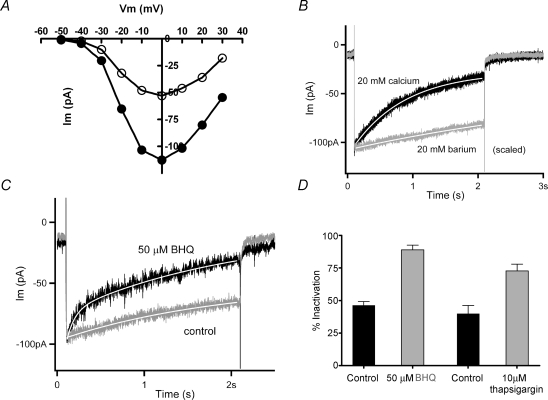Figure 4.
The effects of calcium influx and internal stores A, current–voltage relation obtained with 20 mm calcium or barium in the external saline (holding voltage −70 mV). Barium current was on average twice the amplitude of calcium current in all cells tested. B, a 2 s step to 0 mV from a holding voltage of −70 mV produced a slowly decaying inward current (τ= 0.8 s, from single exponential fit, continuous white line) carried by 20 mm calcium (0.1 mm EGTA buffering). Substitution with barium yielded a larger current (scaled by 0.63) that decayed much more slowly (τ= 6.5 s, from single exponential fit, continuous white line). C, membrane current during a 2 s step to 0 mV before (‘control’) and 4 min after the addition of 50 μm SERCA blocker benzo-hydroquinone (‘50 μm BHQ’) (20 mm calcium external, 1.0 mm EGTA internal buffer, holding voltage −70 mV). Inactivation was more extensive in the SERCA blocker. Peak control current was scaled by 0.8. Continuous white line indicates double exponential fit to each record. D, the percentage inactivation in control (46.2 ± 2.9%, mean ±s.e.m., n = 5), 50 μm BHQ (88.9 ± 3.5%, n = 5), control (40 ± 11%, n = 3) and 10 μm thapsigargin (72 ± 10%, n = 4). Each treatment condition differed significantly (P < 0.03) from its independent control (Student's two-tailed t test).

